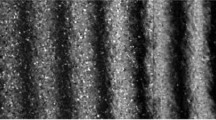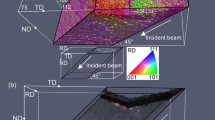Abstract
We have carried out systematic experiments to explore the range of applicability of the two direct methods which are available for the determination of the nature of small clusters. Experiments in heavy-ion irradiated silver and copper, including direct comparisons with the results of Black-White contrast analysis (B-W), forced us to the conclusion that use of the 21/2D technique for the analysis of faulted loops is effectively impossible because of reciprocal-lattice spike and other effects. We used B-W analysis to investigate the nature of the clusters produced by room-temperature heavy-ion irradiation of copper. In-situ irradiations were performed in the Argonne HVEM-Tandem Facility using 40keV and 80keV Kr+ ions. Nearly all of the analysable first-layer loops were found to bevacancy in nature. Some deeper clusters were also certainlyvacancy. There isno unequivocal evidence forinterstitial loops under these conditions. The near impossibility of establishing that interstitial loops arenot present is shown by the fact that a large fraction of loops - over 50% - could not be analysed either because they did not display clear B-W contrast under any condition or sufficiently consistent B-W contrast under several different operating conditions.
Similar content being viewed by others
References
H. Fukushima, Y. Shimomura and M.W. Guinan, J. Nucl. Mat., 155-157, p. 1205 (1988).
H. Fukushima, Y. Shimomura, M.W. Guinan and M. Kiritani, Phil.Mag. A60, p. 415 (1989).
H. Fukushima, Y. Shimomura, M. Kiritani, M. W. Guinan, H. Gerstenberg, I. Mukouda and T. Mitoma, J. Nucl. Mat. 212-215, p. 154 (1994).
T. D. de la Rubia and M. W. Guinan, Phys. Rev. Lett., 66, p. 2766 (1991).
A. J. E. Foreman, W. J. Phythian, and C. A. English, Phil. Mag. A66, p. 671 (1992).
J. B. Mitchell and W. L. Bell, Acta.Met 24, p. 147 (1976).
U. Essman and M. Wilkens, phys. stat. sol. 4, p. K53 (1964).
M. Riihle, M. Wilkens and U. Essman, phys. stat. sol. 11, p. 819 (1965).
M. Riuhle and M. Wilkens, Phil. Mag. 15, p. 1075 (1967).
H. Fukushima, M. L. Jenkins and M.A. Kirk, Phil. Mag. A, in press (1997a).
H. Fukushima, M. L. Jenkins and M.A. Kirk, Phil. Mag. A, in press (1997b).
D. I. Piskunov, Soy. Phys. Sol. State, 27, p 2125 (1985).
M L Jenkins, J. Nucl.Mat. 21, p. 124 (1994) quoting University of Stuttgart doctoral theses by W. Grüschel (1979) and A. Laupheimer (1981).
Author information
Authors and Affiliations
Rights and permissions
About this article
Cite this article
Jenkins, M.L., Fukushima, H. & Kirk, M.A. On the Determination of Loop Nature in the Tem. MRS Online Proceedings Library 439, 289–300 (1996). https://doi.org/10.1557/PROC-439-289
Published:
Issue Date:
DOI: https://doi.org/10.1557/PROC-439-289




